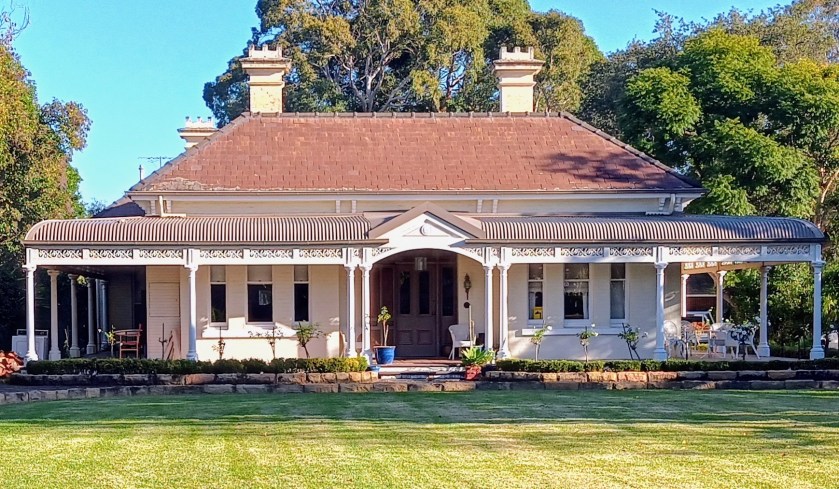By Cathy Jones
‘Hawthorne’, 78-80 Abbotsford Road Homebush was built c.1886 and is one of the oldest houses on the ‘Village of Homebush’ estate. The section of Abbotsford Road where ‘Hawthorne’ is located, between Meredith Street and Bridge Road, was the first section of Abbotsford Road to be developed. Other significant Victorian style properties, which are heritage listed, are located near ‘Hawthorne’ including ‘Rothesay’, ‘Broughlea’ and ‘Stockman Manor’.
’Hawthorne’ is a heritage listed item and also located within the Abbotsford Road Heritage Conservation Area. ‘Hawthorne’ is described as:
‘a single storey rendered brick Victorian house with a symmetrical façade. Elements include a slate hip roof, return verandah with a corrugated iron bull nosed roof, rendered chimneys, paried eave brackets, side and fanlights to entry door and rectangular bays to the street façade. A small gable is located over the entry. A rare group of Forest Red Gums (Eucalyptus tereticornis) are featured in the rear garden. These are examples of remnant regrowth from the original tall open forest of the Homebush area. It is likely that these trees may have self-seeded from a single larger parent tree which has now been removed. These trees are included on Strathfield Council’s Significant Tree Register as representative of an important remnant population of the original forest’.
‘Hawthorne’ was built c.1886 for Frederick William Binney Esq. to a design by Blackett Bros. In January 1886, the Blackett Bros placed a tender advertisement in the Sydney Morning Herald for builders:
“To Builders. TENDERS are invited for a Cottage at Homebush, for F. W. Binney, Esq. Plans and specifications may be seen at the Offices of the Architects, to whom tenders are to be addressed, on or before MONDAY, the 16th February. BLACKET BROTHERS, Architects. Bond-street.”
The architectural firm of Blackett Bros, consisted of Cyril and Arthur Blackett, the sons of prominent architect Edmund Blackett (1817-1883), a former NSW colonial architect. Cyril Blackett trained as an architect in England and gained his qualification with the Royal Institute of British Architects. He was elected President of the Institute of Architects (NSW) in 1903. His brother Arthur was a surveyor. After the death of Edmund Blackett in 1883, the Blackett Bros took on a number of jobs.
It is not known who the builders were but the owner of the house Frederick William Binney was notable person. Binney was the Secretary of the Newcastle-Wallsend Coal Company and the Northern Collieries Association. Binney was associated with development of the coal industry in NSW from 1861 to his retirement in 1900. His obituary notes in particular, his skill in negotiations with miners and unions, noting that he “displayed much tact in the difficult negotiations which arose, although his energies were mainly exerted on the side of the owners”. When he relinquished duty for the company and the association the colliery officials in the northern mining district presented him with an illuminated address. The mine ceased business in 1935. There is a street in Wallsend, a district of Newcastle named for him.
Binney was the owner and occupant of the house until his death in July 1901. His wife Isabella died at ‘Hawthorne’ in 1899. The following article was published in the Sydney Morning Herald:
FUNERAL OF THE LATE MR. F.W. BINNEY
The funeral of the late Mr. F. W. Binney took place on Saturday afternoon from Hawthorne, Abbotsford-road, Homebush. The remains in a polished co-tar coffin, were interred in the Church of England section of the Necropolis, and were followed by several old friends of the deceased and gentlemen connected with the coal trade of the State. The service was conducted by the Rev. H. J. Rose. Wreaths and sympathetic messages were received from the directors and manager of the Newcastle Coal Company, the directors, secretary, and officers of the Newcastle Wallsend Colliery Company, Messrs, J and C. Brown, P. F. and H. Langwill, Alderman A W. G. Gregg, and there were present Messrs. V. H. Binney (nephew), A R. Douglas, Alderman John Wheeler, Captain J. L Fawkes, Fraser, S. Thompson, P. Reid, J. Mullens, A. Ross (manager of the Wallsend Colliery), T. B. Frith, T. Chilcott, Iredale, Price, and Johnston.
Following Binney’s death, the house was purchased by Dr Arthur Salter, a medical doctor. The house was maintained in the ownership of the Salter family until at least the mid-1960s.
The house was first heritage listed in 1992. It is also classified by the National Trust.
References
“Advertising.”, Sydney Morning Herald, 27 Jan 1886, page 11
Fox & Associates, Strathfield Heritage Study, 1986
Jones, Cathy, Strathfield Council Building Approval Records 1913-1922, 2005
Sands Sydney and Suburban Directory, 1880-1932/3
Strathfield Council Building Registers Vol. 4 (1928-1935) and Vol.5 (1935-1940)
Strathfield Council Building Approval Index Cards 1950s to early 1990s
Strathfield Council Significant Tree Register
Strathfield Council Valuation Lists 1880s

Hawthorne was owned by the Salter family until late 1970, when it was bought by my parents, Trevor and Joyce Thiele. We lived there until 1978. Since then it has changed hands a number of times, I believe, and regrettably some of the original features, which we did our best to maintain, have been removed or otherwise interfered with (for instance, the wonderful, original bath in the main bathroom was removed quite a few years ago). It was a privilege to have lived in such a wonderful home.
LikeLike
Dr Arthur Salter was my great grandfather, so “Hawthorn” is a large part of our family history. Great story Cathy. Thank you.
LikeLike